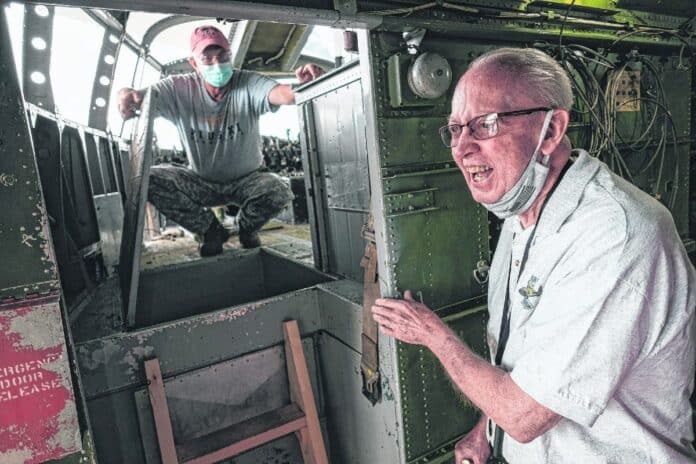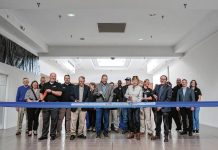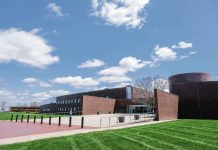
Fifty-one years after returning home from war, Bill Tyler climbed back into the metal-shelled cockpit of an airplane that shaped the course of his life.
After examining the controls, and finding the space where his seat once was, Tyler gazed towards the horizon of the Columbus Municipal Airport — his eyes welling behind his aviators as he recalled memories of days gone by.
Across Tyler’s faded blue T-shirt, the phrase “Back Home Again” was printed in bright yellow type above an image of two “flying boxcars,” the aircraft in which he stood. Near his heart, the word “brothers” was transcribed — more than appropriate given the moment he was sharing with his fellow Vietnam veterans.
On Sept. 23, seven members of the 71st Special Operations Squadron gathered to see the start of a project decades in the making: the refurbishing of a C-119 for the Atterbury-Bakalar Air Museum.
[sc:text-divider text-divider-title=”Story continues below gallery” ]
The former reservists, and their families, toured the hangar-turned-worksite while sharing stories of the famed aircraft. For some of the men, it was the first time they’d seen one of the planes since returning home from service.
Just over a half-century ago, the reservists worked with full-timers at Bakalar Air Force Base (now Columbus Municipal Airport) to fix and maintain C-119 planes. The 71st SOS were activated in April of 1968 and reported for active duty in 1969. They arrived at Nha Trang Air Force Base in Vietnam on March 2, 1969, and spent their time at Phan Rang Air Base. While overseas, the reservists were tasked with protecting U.S. ground troops with AC-119 gunships.
On his way to the airfield for the meetup, Tyler said he, perhaps instinctively, made a wrong turn: He drove to the hangar nearest to where the planes were located in the ‘60s.
According to reservist Jim Alvis, who organized last week’s event, the aircraft used to be parked north of where the Cummins hangar currently is located. He said 36 C-119s, for the 434th Troop Carrier Wing, were stationed at the air base from 1957 to 1969.
The plane at the airport, which was purchased in Greybull, Wyoming, isn’t the exact same model the reservists used to work on. The particular C-119 was built in Hagerstown, Maryland, for the Canadian Air Force, and was later used to fight forest fires. The 40,000-pound plane is not airworthy, with its last known flight taking place in 1990.
“This is pretty much a standard cargo-type configuration used for hauling troops and cargo,” Alvis said. “The aircraft that we had…these had been modified into gunships. They put four 7.62 mm mini-guns in it, a flare launcher, and an illuminator on the back which had a million candle power — they were configured strictly for combat.
Jack Bastin, a fellow reservist, added, “Where the doorway was, there was NODs — night observation devices. The door came off, and all we had was a bar across there. A guy stood there in the door with the prop turning. That night observation scope would amplify what little light there was at nighttime so we could see troops and images on the ground.”
Bill Evans’ assessment of the differences between the planes was simple.
“Ours were all put together,” he joked.
Before flying to Vietnam, the 71st SOS stopped at a handful of air bases stateside. One of those flights was one the group frequently discusses — a subzero trip to Elmendorf Air Force Base in Anchorage, Alaska.
“On every flight, there’s a point of no return to go back,” Earl Wall, a former reservist, said. “You have to go on. We ran into an ice storm and it started building up on the leading edge of the wings. I took all the heat from the aircraft and put it into the propeller and leading edge of the wing to try to de-ice in flight. The pilot was able to land it center, but it was pretty scary.”
All of the veterans said that the one word they’d use to describe the C-119s was “reliable.”
“It was the first aircraft that I had actually worked on,” Wall said. “The engines (two Wright R-3350 Duplex Cyclone radial engines) were quite dependable. When we flew into St. Augustine, Florida, and turned a stock plane in for a gunship, we flew out over the coast and would shut one engine down and fly on one. I was amazed. Those engines — it could fly on one.”
The restoration of the C-119 is being done by a group of around 10 volunteers. Skip Taylor, a leader on the project, said volunteers are currently working on weatherproofing the fuselage so that the plane can be moved outside. It will eventually be placed just south of the McDonnell Douglas F-4 Phantom II aircraft outside the museum.
He said the outer wings won’t be installed until it’s out of the hangar, and that “if all the stars line up” the tail booms will be cleaned out, and the horizontal stabilizers will also be put on, in the near future. Once those tasks are completed, work can start on installing the engines and propellers.
Nick Firestone, president of the Atterbury-Bakalar Air Museum board, said the group hopes to move the plane outside between late-October and mid-November. Once complete, the aircraft will be about 86-feet long with a 110-foot wingspan while standing 27-feet tall with the tail.
Evans said he wasn’t sure if he’d ever see a C-119 in Columbus again, but he is glad he did.
“It’s pretty moving to see one here,” Evans said. “ I think it’s very important to have it. I brought my daughter to see it — to see what I worked and flew on. I have other kids that I’m going to get down here once it’s complete and everything. I think it’s important for posterity.”
While Alvis saw the C-119 for the first time last month, he said he still gets emotional while standing beside it.
“When I first saw it a month ago, in a way, it was stepping back 51 years,” Alvis said. “You see so many things, and all of these different memories pop back into your mind.
“…It brings back a tremendous amount of memories and recollections of the aircraft. Things that have been long since forgotten.”
[sc:pullout-title pullout-title=”For more photos” ][sc:pullout-text-begin]
For more photos of the visit, see therepublic.com.
[sc:pullout-text-end][sc:pullout-title pullout-title=”To learn more” ][sc:pullout-text-begin]
Visit atterburybakalarairmuseum.org/project-charlie-119.html for more information about the project.
People interesting in volunteering for the project should contact the Atterbury-Bakalar Air Museum at 812-372-4356.
[sc:pullout-text-end]




